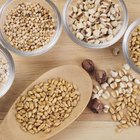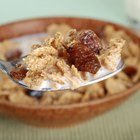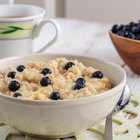Arx0nt/iStock/GettyImages
A continental breakfast is a light, satisfying meal to start the day. Hotels around the world serve this traditional breakfast, which consists of baked goods, fruit, dairy products, cereal and both hot and cold beverages. Serving a continental breakfast at home for family or house guests doesn't require a lot of planning and is usually enough to tide people over until lunch.
Benefits of a Continental Breakfast
The continental breakfast is most often served at hotels, business meetings, team meetings, events, trainings or for any breakfast gathering where a group of people are in attendance. Consisting of simple items, like pastries, fresh fruit, cereal and coffee, the cost is kept low, especially compared to having a pancake station or made to order omelets. Set up as a buffet, most items are served cold or at room temperature, except for coffee and tea, which means preparation and clean up are quick and easy.
Baked Goods
Baked goods are an essential part of any continental breakfast. Traditional items include bread, muffins, croissants, bagels, scones and pastries. Doughnuts may also be served, though they are not traditional. Spreads, such as butter, margarine, cream cheese and jam, should accompany the baked goods. Baked goods are normally served at room temperature in a basket or on a large serving plate.
Fruit
If your guests are fans of fresh fruits, such as strawberries, melon, grapefruit, banana, blueberries, raspberries, orange and grapes, then they will probably be satisfied with the breakfast items being served. Tropical fruits, such as pineapple, papaya, mango and guava, are not as traditional but are still served in places where they are available. Fruit may be topped with honey, seeds, cottage cheese or other items. You may also serve a mixed fruit salad.
Dairy and Cereals
Dairy products, such as yogurt, cheese or milk, provide your guests with protein options. It is traditional to serve plain or fruit-flavored yogurt with granola and fresh berries. Cold cereals, such as corn flakes or oat bran are also common. Serve cold cereals with milk and fruit, such as strawberries or blueberries. If you want to include a hot item, then oatmeal or cream of wheat can be an easy to make and popular choice. Mild-flavored cheese, such as mozzarella or soft cheddar, paired with fresh bread or crackers, are another option that attendees may enjoy.
Beverages
No breakfast is complete without coffee. Consider offering your guests coffee, tea, espresso, cappuccino and possibly hot chocolate as hot beverage choices. Remember the cream, milk, honey, sugar and sugar-substitutes to go along with the beverages. Most continental breakfasts also include cold beverages such as fruit juice, milk or water. Orange and grapefruit juice are the classic fruit juices, but there are plenty of other options, including strawberry juice, peach juice and pineapple juice. Provide cold beverages in a large pitcher for individual serving.
Related Articles

How to Plan a Brunch Menu
What Foods Do Hispanics Make for ...

Is Kashi Cereal Healthy?

Calories in a Bowl of Raisin Bran Cereal

The Calories in a McDonald's Hot Fudge ...

Couples Clubs in New Orleans

How to Make Coffee for a Crowd

Wedding Day Lunch Ideas for the Bridal ...

Vegetarian Menus for Large Groups

Simple Menu Ideas for Small Wedding ...

Oatmeal & Full Liquid Diet

A Brunch Menu for a Kid's Birthday Party

Second Wedding Gift Etiquette

How Much Whole Grain Should You Eat a ...

Places to Go for a Baby Shower in the ...

How to Throw an Irish Tea Party

What Is a Bridal Brunch?
Can Kids Go to Dave and Busters?

Menu Plans for a First Birthday Party

Christian Ladies Brunch Ideas
References
Writer Bio
Charlie Higgins is journalist, editor and translator based in Buenos Aires, Argentina. He has written for a variety of lifestyle and niche market websites, including International Food Trader, The Olive Oil Times, microDINERO, Sounds and Colours, Connecting Worlds and The Buenos Aires Reader.